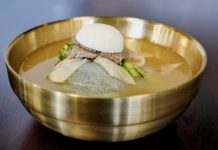
If anyone orders merlot, IÔÇÖm leaving. I am NOT drinking any f***ing merlot!ÔÇØ
So said oenophile Miles Raymond in the 2004 movie Sideways╠²ÔÇö and many moviegoers apparently took his condemnation of the grape to heart.
Articles across the internet chronicle what some have dubbed ÔÇ£The Sideways EffectÔÇØ ÔÇö a decline in popularity of merlot and/or an increase in demand for pinot noir, the virtues of which Miles extolled at length in the film ÔÇö following the movieÔÇÖs release.
More than a decade later, Lee Lutes, winemaker at Black Star Farms on the Leelanau and Old Mission peninsulas, still vividly recalls the backlash.
ÔÇ£Oh, yeah, that dip was basically nationwide ÔÇö maybe worldwide,ÔÇØ he says. ÔÇ£Anything that had merlot on it, people were like, ÔÇÿI donÔÇÖt want it.ÔÇÖ ÔÇØ
Wally Maurer, owner/winemaker at Domaine Berrien Cellars and Jeff Lemon, owner/winemaker at Lemon Creek Winery, both in Berrien Springs, say theyÔÇÖve experienced the same phenomenon downstate.
ÔÇ£We get a lot of people coming in to the winery saying, ÔÇÿOh, I donÔÇÖt drink merlot,ÔÇÖ ÔÇØ says Maurer, who has grown merlot since 2004. ÔÇ£It has a bad rap as a flabby, uninteresting red wine for new wine drinkers. We tell them they need to try a Michigan merlot and it will change their opinion. And it usually does!ÔÇØ
╠²
Avoiding the ÔÇÿFruit BombsÔÇÖ
Paul Hamelin, owner of Verterra Winery on Leelanau Peninsula, is a huge fan of what the grape can do in Michigan.
ÔÇ£The flavor profile and texture can be big, dark, and brooding in very warm years, yet wonderfully nuanced, allowing multiple layers of complexity,ÔÇØ he says. ÔÇ£It also is an outstanding grape to blend with other reds or to feature it as the main grape, similar to winemaking in Bordeaux.ÔÇØ
Lemon says he loves the grapeÔÇÖs ÔÇ£richnessÔÇØ and its balance of acid and tannins. He describes it as ÔÇ£big but soft,ÔÇØ with notes of ÔÇ£berries dipped in caramel flavors.ÔÇØ
Brian Hosmer, winemaker at Chateau Chantal and Hawthorne Vineyards on Old Mission Peninsula, says he likes the ÔÇ£delicate blueberry noteÔÇØ that often differentiates a Michigan merlot from other regionsÔÇÖ versions.
In comparison to cabernet sauvignon, ÔÇ£I would say Merlot is softer; it has a very pretty fruit profile that can be a bit more floral than cabernet,ÔÇØ Lutes says. Yet, it has every bit the plum, dark fruit, cassis, black currant, and blackberry-oriented notes, he adds.
ÔÇ£ItÔÇÖs got a similar fruit profile as cabernet, but it lacks all that (heavy) tannin, and usually where itÔÇÖs made and made well, itÔÇÖs not going to be as alcoholic ÔÇö╠²itÔÇÖs not going to be as heavy as cabernet,ÔÇØ he explains.
Lutes argues that one of the main problems with public perception of merlot ÔÇö besides the scorn from a film character ÔÇö is that itÔÇÖs often overwrought, overripe, over-alcoholic and over-oaked in warm weather growing climates.
ÔÇ£California merlots that are overripe fruit bombs and overly sweet have ruined the publicÔÇÖs perception of merlot as a varietal,ÔÇØ Maurer agrees.
For consumers seeking quality merlot, Lutes warns that itÔÇÖs not the kind of bottle one can snag off the clearance rack.
ÔÇ£ThereÔÇÖs been so much bad merlot made that for the general consumer thatÔÇÖs just getting into wine thatÔÇÖs looking to spend $10 or so on a bottle, theyÔÇÖre not going to get a good merlot for that,ÔÇØ he says. ÔÇ£YouÔÇÖre probably better off getting a red table wine or red blend for a $10 price point. I think you have to step up to the $15-$20 range to get a good (Merlot).
ÔÇ£I think part of the reason that itÔÇÖs important to spend a little bit more money on it is, merlot is one of those varieties that anyone can make mediocre,ÔÇØ he adds. ÔÇ£It takes a winemaker with a bit of passion and a bit of real interest in the variety to make a good one. You donÔÇÖt want to just be buying industrial merlot.ÔÇØ
Luckily for Michigan wine lovers, most merlot made from in-state grapes are produced relatively small batch, avoiding many of the pitfalls noted by Lutes.
╠²
The Whys and Why Nots
Merlot is on the rise in Michigan: According to data from the Michigan Grape and Wine Industry Council, the number of acres planted have more than doubled over the last decade, from 60 acres in 2006 to 125 in 2016.
But its presence still pales in comparison to MichiganÔÇÖs darling grape, riesling, at 675 acres in 2016, and to Miles RaymondÔÇÖs favored grape, Pinot Noir, at 260 acres in 2016.
Kip Barber, owner, grower, and winemaker at Lone Oak Vineyard Estate in Grass Lake, has been growing merlot for 20 years. He decided to plant it originally after tasting other merlots grown on the same latitude in Michigan and Ontario, and kept planting it because of ÔÇ£the wonderful flavor profile.ÔÇØ
ÔÇ£I like the black cherry flavors, the wonderful tannins, the deep color, and the ease of ripening in our region,ÔÇØ he says.
Joe Herman, owner/winemaker at Karma Vista Winery in Coloma, says he planted merlot for a simple reason: ÔÇ£because we like to drink merlot.ÔÇØ
ÔÇ£We get these marvelous black cherry notes and soft tannins,ÔÇØ says Herman, who typically offers two different merlot bottlings: one with little to no oak, focusing on the berry, and a reserve version thatÔÇÖs ÔÇ£all about the interplay of oak and fruit.ÔÇØ
For Hamelin, the driving factors behind him first planting merlot 11 years ago were numerous. It doesnÔÇÖt require as much heat and sunshine as zinfandel or cabernet sauvignon to ripen, it had a 20-year history of performing well in the area, and high-quality wines made with it in France have a major appeal, Hamelin says.
Also, ÔÇ£the clusters are loose and open, which reduces the chance of mildew forming and ruining the fruit,ÔÇØ he explains. ÔÇ£We get dew at night here in the Midwest almost every night from mid-August to November, so big, loose, open clusters are wonderful.ÔÇØ
Hamelin reports consistent success with the grape: ÔÇ£In most every year, we can get the fruit ripe enough to make good, consistent, delicious red wines.ÔÇØ
The main downside is that merlot is extremely sensitive to winter damage, says Glen Greiffendorf, winemaker at 12 Corners Vineyards in Benton Harbor. That can be perilous in a place so susceptible to brutal winters, as seen back to back in 2014 and 2015.
ÔÇ£It is one of the most cold-tender varieties that we grow, so if there is a challenging winter or a spring frost, you can bet that the merlot will be hit by it,ÔÇØ Hosmer agrees.
Despite the rising acreage data, Lutes says he isnÔÇÖt hearing anecdotally of many growers planting new merlot these days, which he attributes to the cold tenderness ÔÇö and, even now, to the Sideways╠²phenomenon. At Black Star Farms, he says, merlot sells best out of the tasting room, where staffers can actively encourage guests to try it.
ÔÇ£If they walk into a retail store, it may not be the first thing they reach for,ÔÇØ he says.
In Michigan, Barber finds that merlot faces some of the same perception challenges as other reds.
ÔÇ£The perception for reds, in general, here in Michigan is that a Michigan red would be thin and lackluster,ÔÇØ he says. ÔÇ£However, that perception is turning around, particularly as people taste the European (Vinifera) red varieties being grown in Michigan.ÔÇØ
David Butkovich, owner and winemaker at Cody Kresta Vineyard and Winery in Mattawan, believes merlot in Michigan tends to sell better bearing a proprietary name instead of the varietal name due to the public perception, but he believes avid promotion by tasting room staffers may help turn around merlotÔÇÖs reputation.
ÔÇ£There is a huge potential for merlot in Michigan with good winemaking and good education to the consumer,ÔÇØ he says. ÔÇ£I feel this can be a top-quality grape for Michigan, and I feel Michigan merlots can be world class.ÔÇØ
Cortney Casey is a certified sommelier and co-founder of ,╠²a website and online community that promotes the entire Michigan wine industry. SheÔÇÖs also co-owner of Michigan By The Bottle Tasting Room, tasting rooms operated in partnership with multiple Michigan wineries, located in Shelby Township, Royal Oak, and Auburn Hills. Contact her at cort@michiganbythebottle.com.
╠²
|
| ╠² |
|








